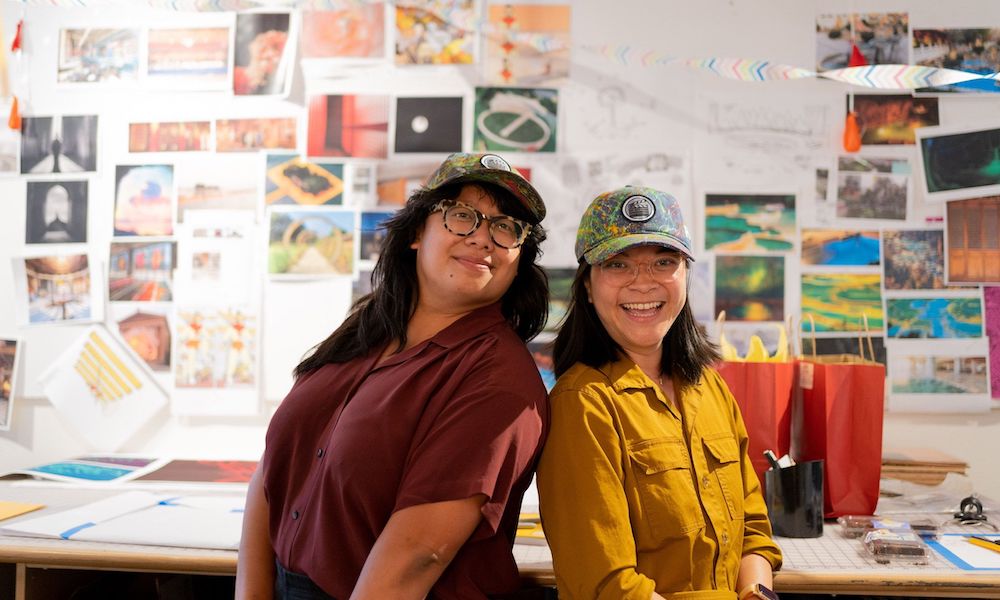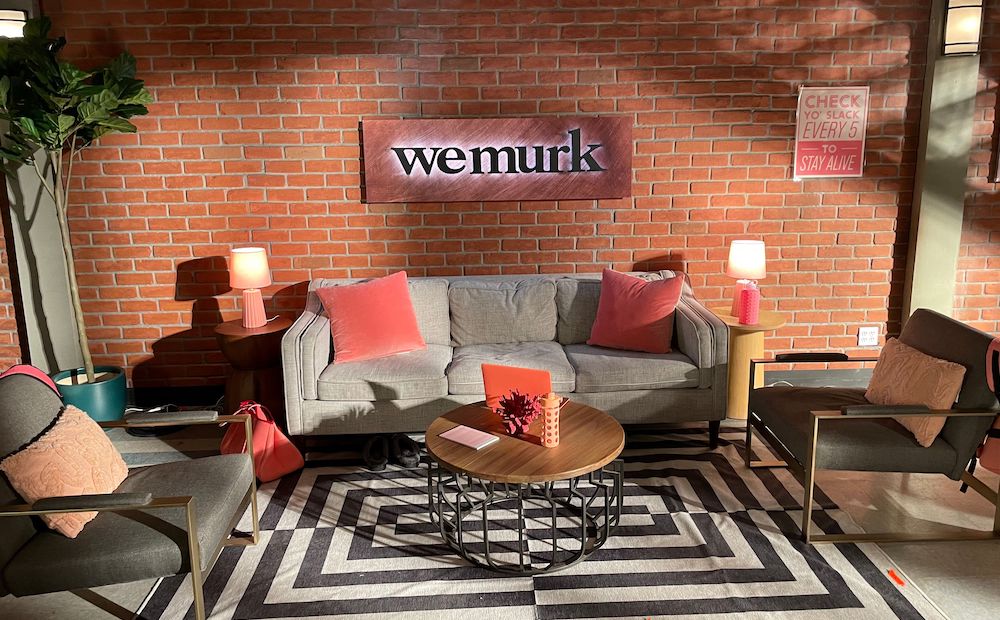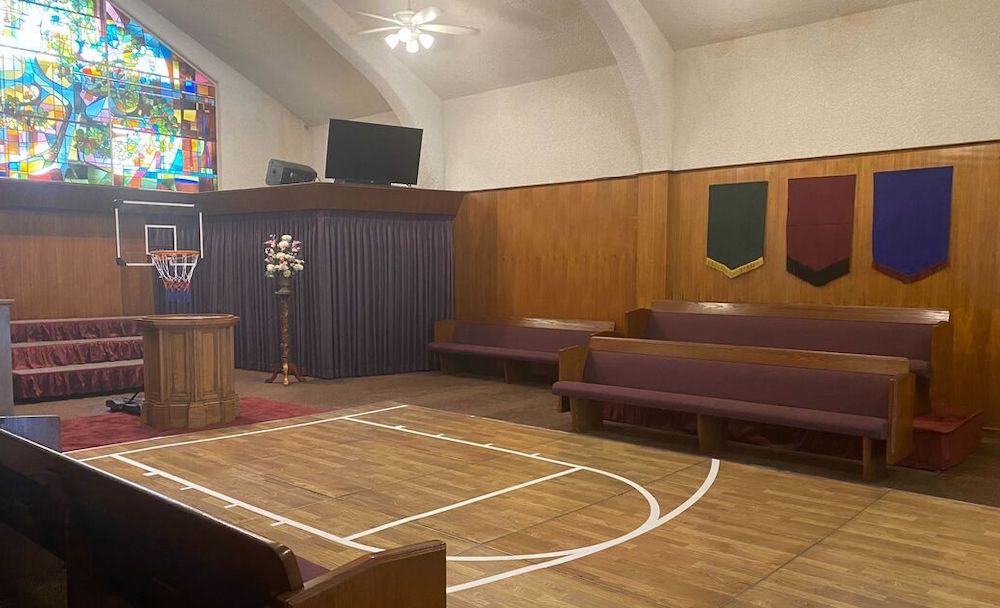
This year marks the second consecutive Emmy nomination for production designers Cindy Chao and Michele Yu, who have been working together for nearly two decades. Their work on the final season of A Black Lady Sketch Show has earned them a repeat bid, and they have plenty to share about the pleasure of being part of that series.
Below the Line spoke with the dynamic duo about building new sets for each season of the sketch series and the joy they feel when they get to hear the actors read their lines and enhance the written jokes. They also shared their efforts to include Black-owned businesses in their sets, and the solidarity they feel in supporting a traditionally underrepresented community in this television spotlight.
They spoke about how they see aspects of themselves in the story of another show they worked on this year, American Born Chinese, and how their own relationship has evolved over the course of many years of working together in the world of independent film.
BTL: For your work, does the conception of the set come first, or does the sketch dictate that?
Yu: Oh, the sketch. What we start with is, every season we’ve been fortunate to be invited to the table read for the season. Miraculously, in television, this never happens, but before prep starts, all of the scripts are already written on Black Lady Sketch Show. Every single one, actually more than we end up shooting. So the very first thing everybody does together is they get in a room or on a Zoom and all of the cast comes together and they read through every single sketch. That usually takes two days because there are so many, but it really helps us to see them perform it right out the gate, because you start getting a sense for what the blocking might be and how things might shift and what’s going to be funnier, how that might affect props. All of these things. So even though Cindy and I love to think about the sets as soon as we can and then start designing them out and making sure they’re all different and they’re all really vibrant, the script and the jokes and the funny always dictates what we do.
Chao: And the last two seasons, the scripts have always included a cover page before each sketch, and the writers do such a great job literally describing not in detail, but very briefly, about each of the characters, the scenario, and a brief line of the setting that we’re about to take place in. Going to those table reads, like Michele said, it’s so informative, because the comedy really does come alive. It’s so different to see the actors perform it than reading it on the page. Sometimes when I’m reading on the page, I sometimes don’t get the jokes, but when I see it performed, it’s so different. It really is a great way to start the season, because you get so much excitement from everyone.
BTL: I read that you never reuse a set from a previous season, which feels like a challenge. I don’t know if it’s a necessity, just something that’s fun to do a lot of extra work?
Yu: Well, the show is very much location-based. Within a single season, every single sketch has a new set. So we’re going through, if there are forty sketches, there might be 60 new sets in the season. For Black Lady Sketch Show, sometimes it’s necessity, but sometimes it’s really just that there are so many sketches and there are so many new ideas. Just in general as a show, we don’t go back to the same place very often. Even recurring characters end up in new settings, and it keeps it fresh and it keeps it new and it keeps it really, really funny.
Cindy and I come from a background of indie filmmaking, so that part is not very daunting to us. That’s just like what the job is in our minds, where you have to stay on your toes and you have to be smart about what you’re doing and the resources you’re doing it with. That’s how we were trained. We were trained up in that world, and a show like Black Lady Sketch Show that is so fast-paced with such quick turnover, it’s perfect. It’s what we know.
Chao: The only things that I think we’ve reused are the little Easter eggs that we insert into some of the sketches. Sometimes we never tell Robin Thede, our showrunner, or the director or our actors, so when they it on set, it’s so fun to see their reaction. Being able to connect the different sketches and create this unified world within A Black Lady Sketch Show that Robin has created just adds a little bit more detail and a little bit more story behind each sketch.

BTL: Do you have any favorite sets that you’ve designed?
Yu: I think in season four, my favorite set was WeMurk. We had a lot of fun with WeMurk, which was the coworking space for gangs. It’s always fun to take that group, and that is a set of recurring characters, and put them in a new, very bougie situation. Cindy, what did you like this season?
Chao: We’ve talked a lot about being able to transform existing location spaces into something different that you’re not expecting. Like the women’s lounge restroom that transformed into a talk show. Baptism Runs on Dunkin’ is always one of my favorites because we have to transform a church sanctuary into a sports arena, which is unheard of. Figuring out how to create that space was also really fun, figuring out the layout of the pews and how to create that into a sports arena by having them face each other. But it’s also the simplicity of creating the marks on the floor that instantly transform a space. It’s just simple things like that. I’m not saying that’s all you need, but just simple things that we can brainstorm with each other really makes the world. Actually, shooting that set was fun, because the whole time there was just so much hollering and clapping that day. It’s not only the set. When you see it come alive with the performances and you see it in the edit, it really does transform altogether.
BTL: This is A Black Lady Sketch Show. How do you work to collaborate with black-owned businesses in the sets that you build?
Yu: Thank you for asking that. We very, very intentionally do that every season, also with black women artists, visual artists for their artwork on the walls. We realized early on that this was not just a sketch comedy show, this was a show with a mission, and a bigger impact potentially. We realized it should be a showcase for celebrating black culture and black entrepreneurs and black creatives at any step we could so. In the art department world, what we have control over in that regard is the sets. What they look like, what gets dressed into them, the products that people are using, the products that get seen. In every season, there’s a wine bottle or a bag of chips or something else in a kitchen, something in a restaurant. Places where you need products, and you’re allowed to see the brands. We’re still very intentionally doing it so that it’s not product placement, so it’s not something that’s in your face, something that’s enmeshed in the world the way we want it to be and supporting the world the way we want it to.
We work with our prop master, Todd Daniels, who’s been with us for three seasons, and Lizzie Boyle, our set decorator who’s been with us all four seasons, and we make sure that we all bring in those elements every time. Three, four seasons in, they’re pros at this. They do all the outreach, they do all the research. It’s an immense amount of work, but it’s worth it. Rather than just renting something from a prop house to fit the bill, it adds something for the cast to be able to see and use real products. It’s world building and it’s something that is an easy thing in our department that we can do, so we do it.
BTL: You also worked on another show this year which is a little bit different, and that’s American Born Chinese. Would you say there’s anything similar about these two projects?
Yu: Oh, yeah. The teams, because we tend to work the same crew. We have a priority, Cindy and I, when we work together, which is always, to choose projects that reflect our values. Both shows, American Born Chinese and A Black Lady Sketch Show, we’re really proud of because they are both shows that were created with the mission in mind of speaking to audiences that have not been prioritized before by the media, by big media. For Black Lady Sketch Show, we come to it as supporters of that storytelling. It’s not our story, but we do our damnedest to make sure that things are real and true and that we listen and that we are very respectful about what we incorporate. For American Born Chinese, it’s the same thing. That is our culture. We’re both Chinese-American, children of immigrants, grew up in Southern California. There are a lot of parallels between our personal stories and that of Jin in American Born Chinese, but the same thing, it’s still very intentional. It’s still about care in approaching that story and relaying it to other people who might not be familiar with the culture and might not be familiar with the nuances. And both shows are celebrations of their cultures, but neither show shies away from what they are and where they come from. Those are the parallels for us.
Chao: And there are things we could relate to in A Black Lady Sketch Show. This past season, there was a sketch called This Nap-Kin All Be Yours. I totally related to that sketch, because, coming from an immigrant household, we never throw anything away, and that was the storyline pretty much of that sketch and how important it is to hold on to something as basic as a napkin from all these takeout food restaurants. It’s finding the comedy of that. Those are things, like even addressing the Wang home in American Born Chinese, those were things that I was ashamed of growing up as a as a child. There was just so much clutter, but then, Black Lady, as Michele mentioned, it celebrates those ideas. It’s something you can like look back and laugh about, because you’re not the only one that does that. You’re not the only person whose family does that. It’s just all relatable things.
Yu: Right. They’re both community building.

BTL: How has your own dynamic changed after working together for over a decade on so many projects?
Yu: Oh my god. We’ve been working together almost twenty years, all told. It’s changed a lot. In the early [indie film] projects, the biggest art department we had was maybe five or six people including us. For a good half of our career, it was just me and Cindy working together as a two-person art department team, which is really not that rare in the non-union world, except that that that sometimes it’s just one person. It’s changed a lot.
In those early years, we very much had to rely on just each other, so that was why we were able to form such a strong working relationship and why we’re still working together today. When you’re in the trenches like that with somebody, you have to find somebody who is actually going to be there and do the work with you and be on the same creative page. If you’re working in film right now in the art department, you’re working on a studio project and you’re working on a union project and you think you don’t have resources, try being given literally two thousand dollars for a feature and told that everything has to come out of that.
When it was just me and Cindy, we very quickly had to learn how to do that work together. And it’s really hard work. It’s really challenging work. A lot of people wouldn’t have been able to, but because we had the two of us together, there was always somebody to share an experience with, to share a gripe with if we needed to and get the venting out before moving on to do the work. There was always somebody to share in the triumphs and how fun things were and do projects with mutual friends.
We met in college and we were already friends from there. As we’ve gotten bigger projects, all it’s really meant is that we have somebody built in as a partner to navigate those waters with too, because it is really challenging when you don’t have a road map, when you don’t come from families that are in the film industry. Neither of us do. When you’re making things up as you go along and figuring out together, you don’t know how to join a union and you don’t know exactly what an on-set dresser does. When you’re coming from a world where you’re the on-set dresser and the production designer and the prop master and all of these other things, and you’ve driven your own trucks, there’s a learning curve. And there’s not a great mentorship system in place if you’re an outsider to that system coming in. We didn’t have mentors coming in, but we had each other, so we could check in with each other. We could both do the research. We could both make connections and figure it out. In that sense, that hasn’t really changed. That’s always been true. But what’s changed is our resources now and our teams.
Chao: Having the partnership and now getting on to bigger projects and bigger crew, we’ve been able to communicate a lot better and a lot differently. A lot of it has to do with all this technology that’s also been new, like Slack and all that. Before it used to all just be through texting, which drove me crazy. We still get texts a lot, but we’ve been able to communicate so much more efficiently that we have more of a balance in our personal lives and work lives, because it’s so easy to get sucked into working x amount of hours. We used to do that in indie projects, because there was the two of us, but now we see the partnership as a benefit because we can actually juggle our personal life with work life, because there’s two of us and being able to communicate better with each other. Letting go of some of that FOMO! If we’re not there at a scout together, we can communicate to each other, and we can communicate it to our crew members, and it’s nice to be able to have that. I’m so grateful because I’m not literally staying up all night, figuring out what to do, getting all these plans out to our crew.
Yu: I highly recommend working in a team if you can swing it if you’re a department head. It’s been pretty magic for us. I know it takes some convincing sometimes. And the art department, this is going to be my stump speech for how challenging their department is and how very little credit a lot of the art departments get for the amount of work they have to do. You’re doing so many things across so many different departments, really. If your department head, if your production designer is pulled in so many different directions and pulled so thin that they can’t even be an effective human being, much less an effective leader or an effective designer, how are you getting your project done? It’s hell for people.
I’m not saying that Cindy and I never get stressed and that we never show that stress. I’m sure our crews have many stories about us. But for the most part, having another person, and I know this wasn’t really your original question, but to put a button on it, having another person has just helped, like Cindy was saying. Even though it hasn’t been a hundred percent, ever, because film and TV is a beast, it’s helped us keep a little bit more balance and more perspective because there is that stress relief of, at least it’s not just me.
Chao: Believe us, we want to be present for everything. But sometimes you’ve just got to, you know, take your child to a doctor’s appointment. Or Michele has home emergencies. And it’s just like, you can’t.
Yu: And then if something like that happens where you really can’t be there, that stress, or not that stress, but that responsibility, stays with the other production designer, instead of trickling down and becoming your supervising art director’s problem, then your art director’s problem, your assistant art director’s problem, becomes everybody else’s problem.
The Black Lady Sketch Show is available to stream on MAX.





